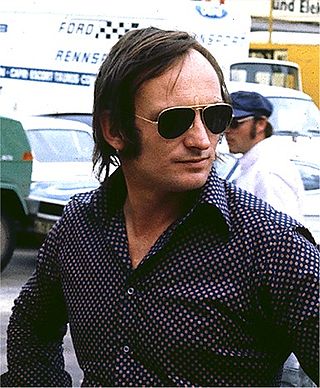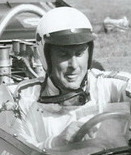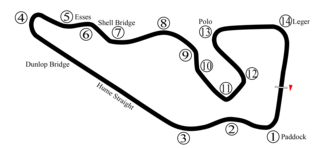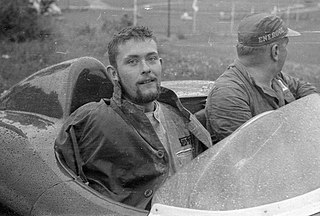
Denis Clive Hulme was a New Zealand racing driver, who competed in Formula One from 1965 to 1974. Nicknamed "The Bear", Hulme won the Formula One World Drivers' Championship in 1967 with Brabham, and won eight Grands Prix across 10 seasons.

Christopher Arthur Amon was a New Zealand racing driver and motorsport executive, who competed in Formula One from 1963 to 1976. Widely regarded as one of the greatest drivers to never win a Formula One Grand Prix, Amon won the 24 Hours of Le Mans in 1966 with Ford, as well as the 24 Hours of Daytona in 1967 with Ferrari.

Repco is an Australian automotive engineering/retailer company. Its name is an abbreviation of Replacement Parts Company and was for many years known for reconditioning engines and for specialised manufacturing, for which it gained a high reputation. It is now best known as a retailer of spare parts and motor accessories.

Graham Peter McRae was a racing driver from New Zealand.

Formula 5000 was an open wheel, single seater auto-racing formula that ran in different series in various regions around the world from 1968 to 1982. It was originally intended as a low-cost series aimed at open-wheel racing cars that no longer fit into any particular formula. The '5000' denomination comes from the maximum 5.0 litre engine capacity allowed in the cars, although many cars ran with smaller engines. Manufacturers included McLaren, Eagle, March, Lola, Lotus, Elfin, Matich and Chevron.

The Tasman Series was a motor racing competition held annually from 1964 to 1975 over a series of races in New Zealand and Australia. It was named after the Tasman Sea which lies between the two countries. The Tasman Series races were held in January through to late February or early March of each year, during the Formula One off season, taking advantage of winter in the Northern Hemisphere to attract many top drivers to summer in the south. The Tasman Cup was the permanent trophy awarded to the winning driver.
Graeme Harry Lawrence is a race car driver from New Zealand. He started serious motor racing in the National 1.5 litre series winning the series decisively in 1968 ahead of David Oxton and Ken Smith. Lawrence then ran half a European F2 series in an uncompetitive semi works F2 McLaren, he found the racing harder than expected and was shaken, by his experience racing in Germany at the Hockenheim race in the rain, were Jim Clark was killed. McLaren allowed Lawrence to build up another F2 chassis in his works and was 2nd in the SR Gold Star series in the car, and first ST driver home in the Tasman races at Pukekohe and Levin.

The BRM P261, also known as the BRM P61 Mark II, is a Formula One motor racing car, designed and built by the British Racing Motors team in Bourne, Lincolnshire, England. The BRM P261 was introduced for the 1964 Formula One season, and its design was an evolution of Tony Rudd's one-off BRM P61 car of 1963. The P261 had a relatively long racing career; variants of the car were still being entered for Formula One World Championship Grands Prix as late as 1968. During the course of their front-line career, BRM P261s won six World Championship races, in the hands of works drivers Graham Hill and Jackie Stewart, and finished second in both the Drivers' and Constructors' Championship standings in 1964 and 1965. Stewart, Hill and Richard Attwood also used works P261s to compete in the Tasman Series in 1966. The BRMs dominated, with Stewart winning four, Hill two, and Attwood one of the 1966 Tasman Series' eight races. Stewart also won the title. The works-backed Reg Parnell Racing team returned in 1967 with Stewart and Attwood, where Stewart added another two wins to his tally. In terms of races won and total championship points scored, the P261 was the most successful car in BRM's history.

Warwick Farm Raceway was a motor racing facility which was in operation from 1960 to 1973. Warwick Farm Raceway hosted numerous major events during its life such as the Australian Grand Prix and rounds of both the Australian Touring Car Championship and the Tasman Series.
The 1972 Australian Grand Prix was a motor race for cars complying with the Tasman Formula, which admitted both Formula 5000 and 2-litre racing cars. It was held at Sandown International Raceway, Victoria, Australia on 20 February 1972.

The 1969 Tasman Series was a motor racing competition staged in New Zealand and Australia for cars complying with the Tasman Formula. The series, which commenced on 4 January 1969 and ended on 16 February 1969 after seven rounds, was the sixth annual Tasman Series. It was won by Chris Amon, driving a Dino 246 Tasmania.
The Rothmans International Series was an Australian motor racing series which was staged annually from 1976 to 1979. Initially open to Australian Formula 1 cars, for the final year it was for ‘’Australian Formula 5000’’, ‘’World Formula 1’’ and ‘’Australian Formula Pacific’’ cars.
The 1971 Tasman Series was a motor racing competition staged in New Zealand and Australia for cars complying with the Tasman Formula. The series, which began on 2 January and ended on 28 February after seven races, was the eighth annual Tasman Series. It was won by Graham McRae of New Zealand, driving a McLaren M10B Chevrolet.
The 1972 Tasman Series was a motor racing competition staged in New Zealand and Australia for racing cars complying with the Tasman Formula. The series, which began on 8 January and ended on 27 February after eight races, was the ninth annual Tasman Series. It was won by Graham McRae of New Zealand, driving a Leda GM1 Chevrolet.
The 1974 Tasman Series was an international motor racing competition which commenced on 5 January and ended on 23 February 1974 after eight races. The championship, which was the eleventh Tasman Championship, was open to Racing cars complying with the Tasman Formula. The winner was awarded the Tasman Cup.
The 1975 Tasman Series,, was a motor racing competition open to Racing Cars complying with the Tasman Formula. Contested over eight rounds in New Zealand and Australia beginning on 5 January and ending on 23 February, it was the twelfth and final Tasman Series. The series was organised jointly by the Motorsport Association of New Zealand and the Confederation of Australian Motorsport and was promoted as the Peter Stuyvesant International Series for the 1975 Tasman Championship.

The 1970 New Zealand Grand Prix was a race held at the Pukekohe Park Raceway on 10 January 1970. The race had 20 starters.
The 1971 Australian Drivers’ Championship was a CAMS sanctioned motor racing title open to Australian Formula 1 and Australian Formula 2 racing cars. It was the fifteenth Australian Drivers' Championship and the first to feature cars complying with a new for 1971 Australian Formula 1 which permitted cars with production based V8 engines of up to 5 litre capacity or racing engines of up to eight cylinders and up to 2 litre capacity. The championship winner was awarded the 1971 CAMS Gold Star and the title of Australian Champion Driver.

The Lola T332 was a race car designed and built by Lola Cars for use in Formula 5000 racing and made its racing debut in 1973. The T332 was successful around the globe with race victories in places such as Australia, the United Kingdom, New Zealand and the United States. The Lola commonly used the 5.0-litre Chevrolet V8 engine, though some competitors in Australia and New Zealand used the slightly cheaper and less powerful Australian made 5.0-litre Repco Holden V8.

Ulf Stellan Albert Johnsson-Norinder was a racing driver from Sweden who competed in multiple classes including non-championship Formula One and the Le Mans 24 hour race in the 1960s and 1970s.











